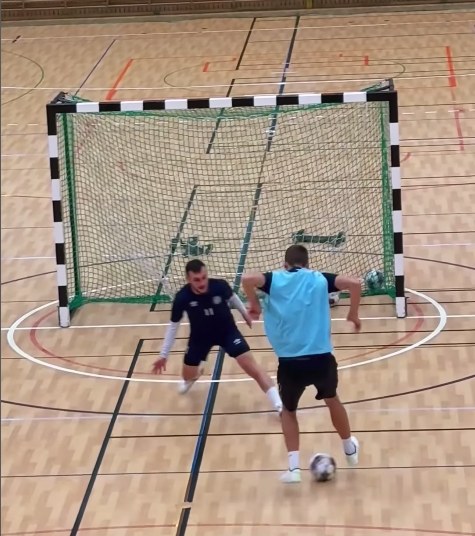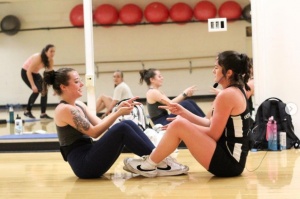Unraveling the Excitement: A Deep Dive into Indoor Soccer Terminology, Scoring, and Winning Defense Strategies
12 min read
What’s the Buzz? A Primer on Indoor Soccer Terminology
Curious about the language of indoor soccer? From ‘boards’ to ‘drop kicks,’ explore the vibrant lexicon that fuels the fast-paced action on the indoor soccer pitch.
Decoding the Jargon
Let’s kick things off by demystifying common indoor soccer terms. What’s a ‘dribble’? How does a ‘slide tackle’ differ from a regular tackle? Get ready to navigate the game like a pro.
FAQs:
1. What is the ‘Boards’ in indoor soccer?
In indoor soccer, the term “Boards” refers to the walls or barriers that surround the playing field. Unlike traditional outdoor soccer, indoor soccer is typically played in enclosed arenas with walls around the field. These boards serve as boundaries, and the ball is allowed to rebound off them during play.
Understanding how to use the boards strategically is a crucial aspect of indoor soccer. Players often use the boards to their advantage when passing, shooting, or defending. Skilful players can execute accurate passes by using the boards to redirect the ball, creating unexpected angles that can catch opponents off guard. Similarly, the boards can be utilized for precise shots on goal, adding an element of unpredictability to the game.
Defensively, players need to be aware of how the boards can affect the trajectory of the ball. Effective defenders use the boards to block passing lanes and limit scoring opportunities for the opposing team.
In summary, the “Boards” in indoor soccer play a unique role, influencing ball movement and tactics on the field. Mastering the art of utilizing these walls strategically can give a team a significant advantage during a match.
2. Can you explain the concept of ‘Drop Kick’ in detail?
In indoor soccer, the ‘Drop Kick’ is a technique used by goalkeepers to restart play after gaining possession of the ball. It involves dropping the ball from the hands and kicking it before it hits the ground. Here’s a detailed breakdown of the ‘Drop Kick’:
1. Starting Position:
- The goalkeeper typically holds the ball in both hands while standing inside their own penalty area.
2. Drop Phase:
- To execute a ‘Drop Kick,’ the goalkeeper releases the ball by letting it drop from their hands toward the ground.
3. Kicking Technique:
- Before the ball makes contact with the ground, the goalkeeper aims to kick it with precision and distance.
- The kicking technique involves striking the ball with the laces of the foot, generating power and accuracy.
4. Launching the Ball:
- The goalkeeper’s objective is to launch the ball as far as possible, aiding their team in transitioning from defense to offense.
- The trajectory of the kick can vary based on the goalkeeper’s skill and the specific game situation.
5. Strategic Considerations:
- Goalkeepers may choose to target specific areas of the field or direct the ball to a teammate to initiate an attacking play.
- Quick decision-making is crucial, as the opposing team will try to capitalize on the transition from defense to offense.
6. Game Impact:
- A well-executed ‘Drop Kick’ can catch the opposing team off guard, quickly changing the dynamics of the match.
- It is an efficient method of restarting play, especially when the goalkeeper wants to distribute the ball quickly and cover a significant distance.
7. Rules and Regulations:
- While the ‘Drop Kick’ is a common technique, goalkeepers must adhere to indoor soccer rules, such as releasing the ball within six seconds and ensuring that both feet remain inside the penalty area until the ball is in play.
Mastering the ‘Drop Kick’ adds a valuable dimension to a goalkeeper’s skill set, providing a strategic advantage in controlling the flow of the game. It’s an essential tool for goalkeepers looking to contribute actively to their team’s overall performance in indoor soccer.
Linking Up: Explore External Resources
Connect with reputable sources to expand your indoor soccer vocabulary. Dive into official rulebooks and glossaries to ensure you’re up-to-date with the latest terms and their meanings here.
Scoring Goals: The Art and Science of Indoor Soccer Scoring
How do you turn a thrilling match into a triumphant victory? Master the art of scoring in indoor soccer and discover the strategies that will leave the opposing team in awe.
The Perfect Shot: Striking Gold in Indoor Soccer
Explore different scoring techniques, from power shots to finesse finishes. What’s the optimal distance for a successful ‘chip shot’? How can you improve your ‘volley’ game? Get ready to unleash your scoring prowess.
FAQs:
1. What is the most effective way to execute a ‘power shot’ indoors?
Mastering the art of executing a powerful shot indoors in soccer is a dynamic process that combines technical precision with physical prowess. The foundation of a potent shot lies in the careful orchestration of body mechanics, starting with the proper positioning of the planting foot. Ensuring a stable base sets the stage for a controlled backswing, allowing players to load energy into their muscles. As the leg swings forward, the engagement of hip rotation becomes a pivotal element, acting as the powerhouse for the shot. Striking the ball with the instep, just above the toes, is the sweet spot where maximum power is generated. It’s in the meticulous follow-through that players achieve accuracy and balance, extending the striking leg toward the target. Head positioning directly over the ball and a keen sense of timing add finesse to the execution, transforming a mere shot into a potent force on the indoor soccer field.
Continual practice is the crucible where these techniques meld into a player’s muscle memory, fostering consistency and precision. Experimenting with angles and adapting the approach based on individual comfort becomes paramount in refining one’s ability to deliver impactful shots. Mental focus throughout the entire motion, from the initial backswing to the final follow-through, is the glue that binds these elements together. Visualization emerges as a potent ally, helping players hone their accuracy and power. In the realm of indoor soccer, mastering the most effective way to execute a power shot is an ongoing journey that combines technical expertise with a player’s unique style, ultimately contributing to the exhilarating and dynamic nature of the game.
2. Can you provide tips for mastering ‘chip shots’ in tight spaces?
Mastering the delicate art of executing ‘chip shots’ in tight indoor soccer spaces requires finesse and strategic awareness. When confined within limited areas, players often find themselves needing to lift the ball quickly and accurately over opponents, making chip shots an invaluable skill. A crucial tip for success in tight spaces is to focus on controlled ball contact. Gently striking the ball with the inside of the foot, just below the center, enables players to create the desired loft without sacrificing accuracy. This controlled approach allows for better manipulation of the ball’s trajectory, a key factor when navigating through congested areas where precision is paramount.
In addition to controlled ball contact, understanding the weight distribution on the planted foot is pivotal. When executing a chip shot in tight spaces, leaning slightly backward and placing more weight on the back foot enhances the lift and loft of the ball. This subtle adjustment in body positioning aids players in deftly maneuvering the ball over nearby defenders or goalkeepers, transforming what might seem like a confined space into an opportunity to make a strategic and unexpected play. Emphasizing these tips during practice sessions not only refines the technique but also builds the confidence needed to seamlessly incorporate chip shots into the repertoire of indoor soccer skills, turning tight spaces into opportunities for creative and effective play.
Defensive Tactics: The Key to Scoring More
Scoring is not just about the attackers – a solid defense sets the stage for successful goals. Discover defensive strategies that will not only protect your goal but also create opportunities for your team to score.
FAQs:
1. How can a team balance between offense and defense for a winning strategy?
Striking the right balance between offense and defense is a nuanced dance that defines a winning strategy in indoor soccer. One of the fundamental keys to achieving this equilibrium lies in effective communication among team members. Players must maintain a constant dialogue on the field, ensuring seamless transitions between offensive and defensive phases. By fostering a shared understanding of each player’s role, teams can swiftly adapt to changing circumstances, whether launching an attack or regrouping to defend. Communication becomes the linchpin that harmonizes individual efforts into a cohesive team strategy, allowing for a fluid and dynamic approach to the game.
Another crucial aspect of achieving the delicate balance between offense and defense is strategic positioning. Players need to be attuned to the ebb and flow of the game, recognizing opportune moments to press forward in attack and knowing when to fall back to fortify the defense. Coordinated movement across the field, combined with an awareness of the opposing team’s tactics, enables a team to dictate the tempo of the game. Emphasizing tactical discipline during training sessions reinforces the importance of maintaining this equilibrium, ensuring that every player understands their dual role as both an offensive and defensive contributor. Ultimately, it is the seamless integration of communication, strategic positioning, and tactical discipline that empowers a team to strike the perfect balance between offense and defense, laying the foundation for a winning indoor soccer strategy.
2. What role does ‘pressing’ play in indoor soccer defense?
In the intricate tapestry of indoor soccer defense, the concept of ‘pressing’ emerges as a dynamic and proactive strategy. Pressing involves a collective effort from the defensive players to apply intense pressure on the opponents, disrupting their passing lanes and stifling their ability to build effective attacks. The primary objective of pressing in indoor soccer is to force turnovers and regain possession quickly, converting defensive efforts into immediate offensive opportunities. This high-intensity defensive approach not only disrupts the rhythm of the opposing team but also creates a sense of urgency, leading to hurried decision-making and potential errors that can be capitalized upon.
Transitioning seamlessly from a pressing strategy requires a meticulous understanding of spatial awareness and teamwork. As defenders press forward to engage the opponents, it is imperative that they maintain cohesion, preventing any gaps in the defensive line that the opposing team could exploit. The success of pressing lies not only in the physical effort but also in the mental acuity of the defenders, anticipating the movements of the opposition and cutting off passing options effectively. By executing pressing as a synchronized unit, a team can not only nullify the attacking prowess of the opponents but also set the stage for swift counter-attacks, exemplifying how this strategic defensive approach is a potent force in the intricate dynamics of indoor soccer.
Winning Defense: Strategies to Secure Victory
Craving victory? It’s time to fortify your defense and turn your team into an impenetrable force on the indoor soccer field. Discover winning strategies that will leave your opponents scratching their heads.
The Art of Defending: A Comprehensive Guide
What does it take to be a defensive maestro in indoor soccer? From ‘marking’ to ‘intercepting,’ delve into the tactics that will keep your opponents at bay and your team in control.
FAQs:
1. How can a team effectively practice ‘zone defense’ in indoor soccer?
Effectively practicing ‘zone defense’ in indoor soccer requires a strategic blend of coordination, communication, and spatial awareness. The fundamental principle of zone defense lies in dividing the playing area into specific zones, with each defender responsible for covering a designated region. To initiate successful training sessions for zone defense, teams should start by clearly defining the roles and responsibilities of players within each zone. This involves understanding how to collectively create a defensive structure that limits the opposing team’s movement and minimizes scoring opportunities.
Communication becomes the linchpin of effective zone defense practice. Players must maintain constant verbal and non-verbal communication to ensure seamless coverage and quick reactions to the dynamic flow of the game. Regular drills that emphasize communication within and between zones can enhance players’ awareness and decision-making skills. Transitioning smoothly between offensive and defensive phases is a key element in zone defense, and practices should focus on simulating game scenarios that require swift adjustments. By reinforcing these communication and transition aspects in training sessions, teams can solidify their understanding of zone defense, creating a synchronized and impenetrable defensive unit on the indoor soccer field.
In conclusion, mastering zone defense in indoor soccer is a multifaceted endeavor that demands coordination, communication, and adaptability. Teams that dedicate focused practice sessions to these elements will not only fortify their defensive capabilities but also develop a strategic edge, making them a formidable force against any opposition.
2. What role does the goalkeeper play in the overall defensive strategy?
The goalkeeper in indoor soccer assumes a pivotal role in shaping the overall defensive strategy, acting as the last line of defense against opposing attacks. One of the primary responsibilities of the goalkeeper is shot-stopping, where their agility, reflexes, and decision-making skills come to the forefront. A proficient goalkeeper not only blocks shots on goal but also strategically positions themselves to cut down angles, making it challenging for the opposition to find the back of the net. Their ability to read the game, anticipate opponents’ moves, and communicate effectively with the defensive line contributes significantly to the team’s defensive solidity.
Beyond shot-stopping, the goalkeeper plays a crucial role in initiating counter-attacks and maintaining possession. With the ability to distribute the ball accurately and quickly, goalkeepers often serve as the first point of attack after a successful defensive play. Their precise throws or kicks can launch swift counter-attacks, catching the opposing team off guard. Additionally, goalkeepers serve as the eyes of the defense, providing a strategic perspective on the field. Their vocal commands and constant communication with defenders help in organizing the defensive line, orchestrating offside traps, and ensuring that the team maintains a cohesive and impenetrable defensive shape. In essence, the goalkeeper serves as the defensive maestro, orchestrating the symphony of defensive movements that contribute to the overall success of the team in indoor soccer.
Mental Toughness: The Hidden Gem of Winning Defense
Defense is not just about physical skills – mental toughness is equally crucial. Explore strategies to maintain focus, stay composed under pressure, and make split-second decisions that can turn the tide in your favor.
FAQs:
1. How can players enhance their mental toughness for better defensive performance?
Enhancing mental toughness is a critical aspect of fortifying defensive performance in indoor soccer. Firstly, players must cultivate a resilient mindset that thrives under pressure. Adopting a positive outlook and viewing challenges as opportunities for growth can help players navigate the intense and unpredictable nature of the game. Visualization techniques play a pivotal role in this process, allowing players to mentally rehearse defensive scenarios, envision successful outcomes, and build confidence in their abilities. By embracing a mindset that sees adversity as a chance to showcase resilience, players can bolster their mental toughness and approach defensive duties with unwavering determination.
Furthermore, fostering effective coping mechanisms is essential in maintaining mental composure during high-stakes defensive situations. Developing pre-game rituals or routines can provide a sense of familiarity and control, mitigating stress and anxiety. Mindfulness and deep-breathing exercises can be invaluable tools for staying present on the field, helping players remain focused and make sound decisions in the heat of the moment. Additionally, learning to compartmentalize mistakes and setbacks, and quickly shifting focus to the next defensive task at hand, is a hallmark of mentally tough players. The ability to bounce back from challenges and stay mentally resilient not only elevates individual defensive performance but also contributes to the overall strength of the team in the dynamic and demanding landscape of indoor soccer.
2. What role does communication play in a strong defensive lineup?
Communication stands as the linchpin in constructing a formidable and cohesive defensive lineup in indoor soccer. Firstly, clear and constant communication among defenders is instrumental in organizing the defensive structure. Effective verbal cues, such as calling out assignments, marking opponents, and signaling potential threats, allow defenders to synchronize their movements and maintain a tight and impenetrable defensive shape. Through proactive communication, defenders can quickly adapt to the evolving dynamics of the game, ensuring that each player understands their role within the collective defensive strategy.
Moreover, communication extends beyond the defenders to encompass the entire team. A goalkeeper’s instructions, for instance, guide the defensive line on positioning and alert them to imminent dangers. Midfielders and forwards play a role in defensive communication by pressing opponents and disrupting their attacking plays. Seamless communication, both verbal and non-verbal, is the glue that binds individual efforts into a cohesive defensive unit. Transitioning from defense to offense also relies on effective communication, as players need to relay information swiftly to launch counter-attacks. In essence, a strong defensive lineup thrives on the foundation of communication, creating a harmonious and well-coordinated team capable of thwarting opposing attacks in the fast-paced arena of indoor soccer.
Wrap up your indoor soccer journey armed with the knowledge of terminology, scoring techniques, and defense strategies. With this arsenal, your team is primed for success on the thrilling indoor soccer pitch. Get ready to conquer and celebrate each hard-fought victory!
To see more blog posts on new games and sports like Breaking, Surfing, Sport Climbing and Skateboarding, be sure to check out our New Games blog page and see our latest posts Blitzball Strike Without Swing: Precision and Strategy Unleashed, Mastering the Kan Jam Game: A Comprehensive Guide to Victory, Unlocking Success: Why Sports and Fitness Resolutions Often Fail and How to Set Goals That Last Through 2024 and Putterball Playbook: From Basics to Brilliance with Connect2PlaySports.com!



